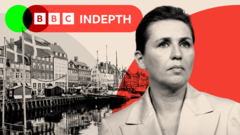The decline in physical mail volumes in Denmark has culminated in PostNord ceasing letter deliveries, impacting their workforce while shifting focus to digital and parcel services. This trend highlights a broader move towards digital communication, as the country embraces its status as one of the most digitalized nations globally, raising questions about accessibility for certain demographics.
Denmark Phasing Out Letter Deliveries Signals Shift to Digital Age

Denmark Phasing Out Letter Deliveries Signals Shift to Digital Age
As Denmark's PostNord announces the end of letter services, a digital evolution takes center stage, reflecting broader trends across Europe in mail communication.
As Denmark's national postal service PostNord prepares to end its long-standing letter delivery services, the country stands at the forefront of a significant shift towards digital communication. Over the past few years, the volume of traditional letters being sent has dwindled, leading to PostNord's announcement in March that it will cease these services by the end of 2023, after 400 years of operation.
Herman Moyano, a postal worker for PostNord in Copenhagen, has witnessed this change firsthand. "The loads are getting lighter,” he says, noting that most deliveries now consist of bills rather than personal correspondence. The situation reflects a broader decrease in mail volumes that has seen the company handle a staggering 90% decline in letters since 2000, going from 1.4 billion letters to just 110 million last year.
PostNord's chief officer, Kim Pedersen, states that Danes receive an average of only one letter a month, and while this reflects personal communication trends, it also echoes a significant rise in online shopping and digital transactions. The company's pivot to focus on its more profitable parcel business, which has provided 700 new jobs despite cutting 2,200 positions, further underscores the changing landscape of postal services.
Cutting down the iconic red post boxes, 1,500 will be removed from Danish streets where many residents, like Nikolaj Brøchner Andrès, admit they haven’t sent a letter in years. Instead, Denmark has embraced a "digital by default" initiative, streamlining correspondence through electronic means and enhancing efficiency.
Addressing the financial aspects of mail, the change in laws allowing private competitors into the postal market, coupled with the VAT rate applied to postage, has seen costs rise, leading to further declines in letter volumes.
Postal sector expert Hazel King confirms that this trend is being observed throughout Europe, as the industry grapples with declining letter volumes and the need for adaptation. Countries like Germany and Switzerland have seen slower declines, but overall, the writing appears to be on the wall for traditional mail services.
In light of the changes, elderly populations, who may struggle to adapt to reduced access to letter services, have raised concerns. Advocacy groups like DaneAge fear the transition could hinder those in rural areas, although DAO, a private delivery firm stepping in to assume some letter services, assures that they will maintain accessibility.
Amidst these advancements, some still cherish the tactile experience of sending letters, as demonstrated by Copenhagener Jette Eiring Williams, who values the personal connection that physical mail provides. This ongoing digital transformation prompts reflection on the future of communication in Denmark and beyond, as societies embrace change while navigating the complexities of maintaining inclusivity among diverse age groups.

















